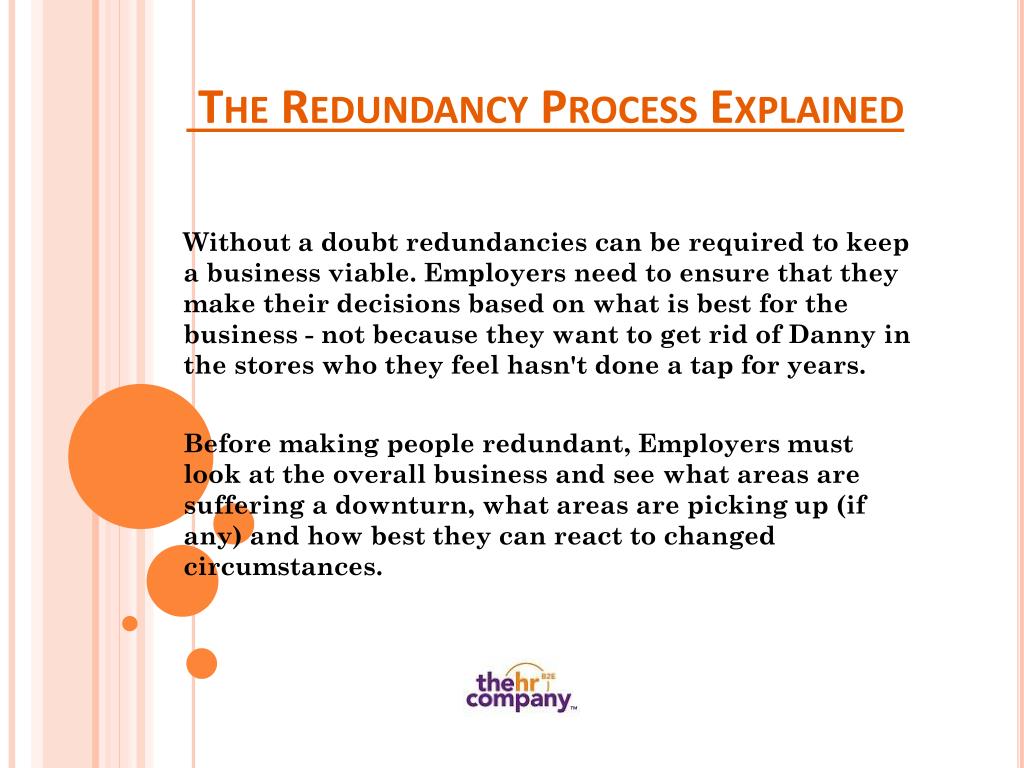Your Rights to Redundancy If Company Goes Bust: UK Employee Protections
Your Rights to Redundancy If Company Goes Bust: UK Employee Protections
Blog Article
Checking Out the Operational Dynamics of Company Redundancy and Its Long-Term Sustainability

Redundancy Techniques for Organization Continuity
In order to make certain continuous procedures, organizations should apply effective redundancy techniques for organization continuity. Redundancy in this context refers to the replication of crucial parts or features within a system to reduce the effect of possible failings. By incorporating redundancy methods, companies can enhance their durability versus interruptions triggered by various elements such as natural catastrophes, tools failings, or cyber-attacks.
One usual redundancy strategy is the implementation of backup systems and data storage services. This includes producing matches of necessary information and systems that can be turned on in instance of a key system failing. Furthermore, companies can develop redundant interaction channels and power resources to preserve connection and procedures during unexpected events.
In addition, cross-training workers to execute several duties within the company can function as an important redundancy technique. This guarantees that essential jobs can still be performed also if crucial workers are not available because of illness or various other factors. On the whole, efficient redundancy techniques are important for businesses to promote functional continuity and decrease the effect of potential disturbances.
Impact of Redundancy on Business Durability
Given the essential function redundancy techniques play in ensuring organization connection, checking out the impact of redundancy on business resilience comes to be critical for recognizing the holistic functional dynamics of a business. Organizational strength refers to an entity's ability to adapt to disruptions, recover from obstacles, and change when required while preserving core features. Redundancy, when tactically carried out, can substantially contribute to enhancing a company's durability despite unexpected difficulties. By having back-up systems, personnel, or procedures in area, companies can much better withstand shocks and continue procedures with marginal disruption.
In addition, redundancy can cultivate advancement and imagination within an organization as staff members really feel empowered to take calculated threats, understanding that there is a safety and security net to sustain them in instance of failure. Overall, the impact of redundancy on organizational strength is extensive, shaping the lasting sustainability and success of a firm.
Stabilizing Effectiveness and Flexibility in Redundancy
Attaining a harmonious balance between functional effectiveness and flexible flexibility is a pivotal obstacle in the calculated deployment of redundancy within companies. Effective operations are important for keeping efficiency and cost-effectiveness, guaranteeing that sources are you can try this out made use of efficiently. Nonetheless, excessive focus on efficiency alone can lead to rigidness, making it difficult for companies to adjust to unpredicted adjustments or challenges. On the other hand, adaptability allows organizations to react nimbly to progressing scenarios, fostering technology and resilience. Yet, also much flexibility without a solid functional structure can result in ineffectiveness and incongruity.
To balance effectiveness and versatility in redundancy planning, organizations should carefully analyze their operational demands, market dynamics, and strategic objectives. Ultimately, my explanation discovering the ideal stability between effectiveness and versatility is crucial for developing a sustainable and durable company in the face of unpredictability.
Long-Term Sustainability With Redundancy Planning
To ensure long-lasting practicality and stability, companies have to tactically align their redundancy preparation with lasting sustainability goals, consequently harmonizing operational effectiveness with flexible flexibility. Lasting sustainability via redundancy planning includes more than just short-term cost-cutting procedures. It calls for a thorough calculated method that anticipates future challenges and opportunities. Companies should see redundancy not as a reactive remedy to prompt issues but as a positive technique for lasting success. By incorporating redundancy planning with sustainability purposes, companies can develop a resistant structure that can endure various market fluctuations and internal changes.

Aggressive Measures for Sustainable Firm Operations
Just how can firms proactively improve their operational sustainability for lasting success? Applying aggressive measures is crucial for firms intending to guarantee sustainable procedures. One key approach is to invest in modern technology and technology to improve procedures, minimize waste, and remain competitive on the market. Adopting sustainable methods such as minimizing energy usage, lessening carbon impact, and optimizing resource use can not only benefit the setting but additionally result in set you back savings over time.
Moreover, promoting a society of constant improvement and learning within the his response company can enhance flexibility to transforming market problems and customer demands. Encouraging staff member involvement in decision-making procedures and supplying possibilities for professional development can increase spirits, efficiency, and general performance. Establishing clear goals, keeping track of essential performance indicators, and on a regular basis evaluating progression are important elements of aggressive sustainability management.
Collaborating with distributors, customers, and various other stakeholders to promote sustainable practices throughout the supply chain can create a causal sequence of favorable impact - redundancy pay if company goes bust. By taking aggressive actions towards functional sustainability, business can develop durability, drive advancement, and protect their long-lasting success in an ever-evolving service landscape
Conclusion

In the world of organizational management, the strategic release of business redundancy stands as a pivotal yet detailed method that demands a delicate balance between operational performance and long-lasting stability. By dissecting the functional dynamics that underpin firm redundancy and evaluating its wider ramifications for organizational resilience and versatility, a nuanced understanding of exactly how redundancy methods can shape the future trajectory of a firm starts to unfold.Provided the critical duty redundancy methods play in ensuring company connection, checking out the influence of redundancy on business resilience becomes necessary for comprehending the holistic functional characteristics of a company. In general, the effect of redundancy on business resilience is extensive, forming the long-term sustainability and success of a company.
In final thought, comprehending the functional characteristics of company redundancy is crucial for making certain long-term sustainability.
Report this page